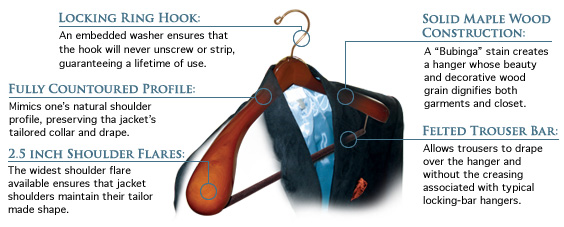
Well-dressed gentlemen, unless they are also very well-off gentlemen, face a very particular dilemma. On one hand, it is indicated to dress properly on a daily basis. On the other hand, however, very few of us are able to entertain a wardrobe that would allow us to change our suits like underwear – a suit is normally worn more than once a week. This is where it becomes important to properly care for it.
This guide will tell you how.
How many suits do I need to minimize wear-out?
 The rule of thumb here would be three. The reason is because we recommend two days of rest for each day of wearing. After a day of wearing a suit, it should be brushed out, possibly receive a quick steam treatment, then be hung on a “suitable” hanger for two days, and stored in a dark and dry place.
The rule of thumb here would be three. The reason is because we recommend two days of rest for each day of wearing. After a day of wearing a suit, it should be brushed out, possibly receive a quick steam treatment, then be hung on a “suitable” hanger for two days, and stored in a dark and dry place.
With three suits, you will be able to constantly alter your suits, giving each of them enough rest to stay nice. It is very important, however, to maintain the discipline and change up your suit after every day. Wearing a suit two days in a row increases wear and tear significantly and should be avoided at any price. This also becomes important when making a purchasing decision: when buying your first three suits, it is indicated to go for neutral patterns and colors. We usually recommend the dark navy blue, the black, and the charcoal suit for starters. Of course, it would be nice to have a fourth or even fifth piece to mix up the routine. But with just the three standards, a gentleman can look good, and prolong the life of his wardrobe considerably.
How to properly brush your fine fabrics.
Brushing your suits is tantamount for suit care. It is the brush that removes the dirt and even the most expensive suit will be worthless, if stained. Clothing brushes come in a variety of quality and a wide price range; using a brush with natural bristles is key, because synthetic bristles are usually stiffer than their natural counterparts. Using a brush with synthetic bristles can scratch the fabric instead of cleaning it. The good news here is that most of the price difference will come down to the wood used for your brushes handles, and not the bristles. You should therefore be able to find a very decent, natural bristles brush for a reasonable price.
 Once you have the right brush, it comes all down to technique. You can use the brush in its normal dry state or you can moisten the brush to remove more persistent stains.
Once you have the right brush, it comes all down to technique. You can use the brush in its normal dry state or you can moisten the brush to remove more persistent stains.
The standard treatment, applied right before hanging your suit on the hanger for its minimum rest of two days, consists of thoroughly brushing the fabric in long, even strokes. The brushing should not be any form of scrubbing, because even the softest brush will damage your suit. If you want to remove a specific stain, apply short, one-directional strokes.
You want to start out against the grain of the fabric, because it will successfully remove the most dust and dirt. You then wrap-up by brushing down the grain, giving it a smooth finish.
If some stains require you to use a wet brush, evenly tip your brush into warm water. Shake of most of the water or roll through the bristles to remove excess moisture; you want your brush to be moist, not wet. Then use it in the same fashion as described above: apply long, even strokes for standard treatment, or use short, quick strokes for individual stains.
If a suit is mostly dusty, brush off the dust using a dry brush and then apply the moist treatment. Don’t apply a moist brush to a dusty suit, because you will turn the dust into dirt and smear it into the fabric, achieving the exact opposite of your goal.
The proper hanger makes all the difference
Suits are cut and tailored to fit you. Just like your waist button is a natural divider of your figure, the shoulder parts are created to lie comfortably on your shoulders. One could say that the suit “feels” most comfortably, when hanging from a nice pair of shoulders. The same is true for hangers: proper suit hangers should mimic the form of shoulders, to relieve the weight from the fabric. The broader the hanger’s ends are, the better they will be for your suit. A good suit hanger has ends with a girth of about 2.5 inches (approx. 6 cm) that will evenly distribute the weight of your jacket. Similar to the hanger girth, you also want to look at the width of your suit hangers. Smaller hangers are obviously for smaller jackets. Again, a poorly fitted hanger will increase the weight on your fabrics and seams, decreasing the suits life expectancy.
A thought on dry cleaning
Sometimes, dry cleaning becomes inevitable. That’s ok, but it should be kept to a minimum. If you have your suit dry cleaned every week or two, it will be done after a year. If you keep proper care of your suit, it will look and feel almost new after five – even ten – years. Ask yourself whether it is truly necessary to dry clean your suit and try our brushing techniques to get rid of the stain that bothers you. It will both save you money and prolong the usefulness of your suit. It’s a win-win, so to speak.
Other thoughts on prolonging your suit’s life
 Overloading: Sometimes, even the smallest things have an impact on how long a suit can be used. Have you ever thought about your pockets? Some people carelessly fill their suit pockets with all kinds of stuff: business cards, keys, cellphones, or wallets. That’s just a short list of a few examples and we could probably go on and on. The point is; every item wears the pocket out. Don’t overload your suit. A nice briefcase does the job just as good – or even better.
Overloading: Sometimes, even the smallest things have an impact on how long a suit can be used. Have you ever thought about your pockets? Some people carelessly fill their suit pockets with all kinds of stuff: business cards, keys, cellphones, or wallets. That’s just a short list of a few examples and we could probably go on and on. The point is; every item wears the pocket out. Don’t overload your suit. A nice briefcase does the job just as good – or even better.
Weather: Yes, it has an impact. Suits are not meant to be wet. A little drizzle for a couple of seconds won’t do any serious harm, but too much moisture will harm your fabric. Threads sometimes expands when wet and contract again when they are drying out. This movement can be avoided by keeping your suit dry when possible.



2 thoughts on “Guide to Suit Care 101”
Comments are closed.